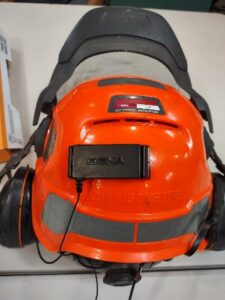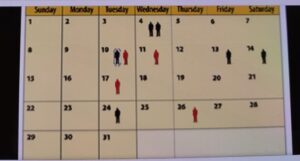Over the past several months I’ve been talking to loggers and sawmill guys about logging safety. I begin by saying logging is the most dangerous occupation in the country. In a room full of loggers this statement always brings agreement and discussion. Some loggers start sharing recent experiences with either, a near miss from a limb coming down near where they were standing, or they show me a scar from a past injury. Either way, it reinforces what we’re saying about logging being dangerous work! I thought it would be helpful to share some of what loggers told me that they do to stay safe while working in the woods.

Communication was an important priority with the loggers I talked to. Wherever they’re working they make sure someone always knows the location of their job. A close family member or friend was the contact most often mentioned. GPS coordinates or a map to the job were given to the local fire/rescue service so, in an emergency, there was no question about where they would be found . The use of two-way radios or wireless headsets were used by crews for added safety. Years ago the expression, “you can’t outrun the radio” was used when someone would try to outrun a police pursuit but in logging the radio is the fastest and most efficient way to communicate between crew members.
Phone Technology can play an important part of logging safety. Everyone has a smartphone, and the “Life 360” app is available and being used by loggers. A few guys I talked to are sole proprietors and working by themselves. This app stays connected with a close friend or family member so that person can see where they are on the ground and that they’re alright. The “Safety Meeting App” (www.safetymeetingapp.com) is another tool for loggers. This app allows you to document monthly safety meetings for OSHA compliance and provides access to multiple training resources to help crew members stay focused on safety.
Safety Alerts are one-page documents which (www.forestresources.org) engage with crew members by describing real life logging accidents or near miss situations. Forestry trade magazines such as Timber Harvesting (www.timberharvesting.com), Southern Logging Times (www.southernloggintimesmagazine.com) and Northern Logger (www.northernlogger.com) often highlight a safety alert for their subscribers.
The interesting thing about this is that when the magazines show up at the house, many loggers go out of their way to find the safety alert (SA) first; secondly, they read the short industry summaries; and, finally, they get to the feature articles. The loggers I talked to said they read it in this order because the SA would help them the most.

There’s a monthly publication in the tree care industry (Arborists) that provides a monthly update of accidents and fatalities to tree care professionals. A calendar is used to illustrate when an injury or fatality occurred. A red silhouette represents injured worker and black silhouette is a fatality. A sad reminder that keeps workers vigilant and safety the top priority!
Here are a few more safety “nuggets” worth sharing—you can decide for yourself if they make sense for you or not.
Some loggers said they always back their tool trucks or pick-up trucks into the job. They know if their truck is headed out, to begin with, it would be a time saver in an emergency.
Another good suggestion came from a veteran logger who said when he got tired, that’s when he got careless! Staying alert and aware at all times was his tip. Building on that thought, a logger commented that when he’s in an unfamiliar situation he asks himself one question: “If this goes wrong, what’s the worst thing that can happen to me?” If he gets the wrong answer, then he’ll find another option.
You could say the last “nugget” is faith-based and came from more than one logger. They say a prayer for protection and safety before starting to work. Everyone has some form of faith. In the Bible, faith is “being sure of what we hope for and certain of what we cannot see.” It’s obvious if you pray for protection and safety, your faith is in God. There’s a simple and well-known expression that could apply to logging: “There are no atheists in foxholes.” The idea is that when you live with death close by, you think a lot about your mortality, its possible abrupt end, and the meaning and value of it all. Maybe that’s why so many loggers believe in God. Logging is dangerous and you could die!
Sharing “best practices” for logging safety is a great way to help yourself and others stay focused and informed when it comes to everyone’s safety. You can contact me or any FRA region manager to tell us what’s working for you. We’ll put it all together to make sure that everyone’s getting the right message.
















